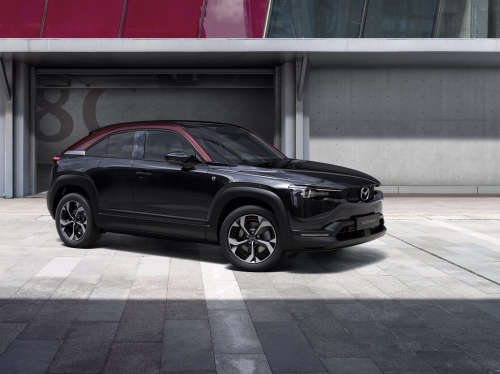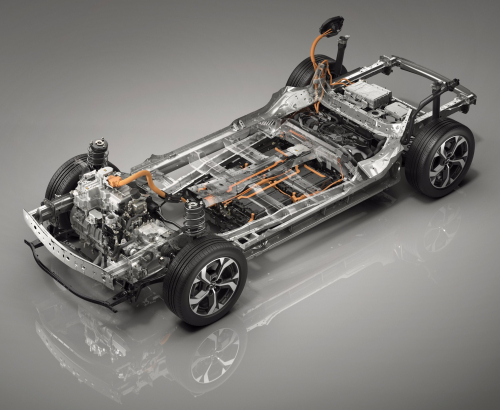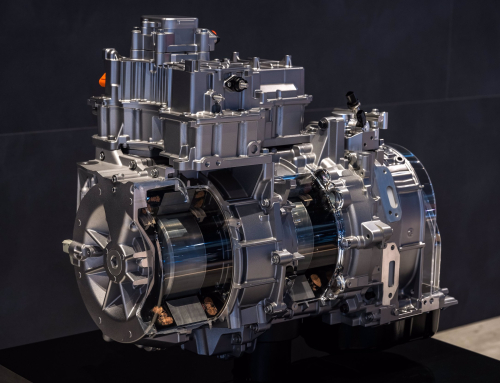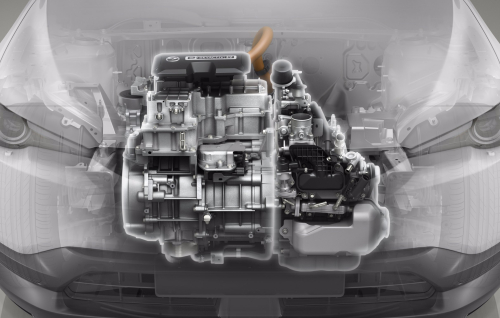The Mazda MX-30 e-Skyactiv R-EV, a plug-in series hybrid model that uses a rotary engine as a generator, made its world premiere at the Brussels Motor Show. (Earlier post.) Mazda MX-30 launched in 2020 as the company’s first mass-production battery electric vehicle, with a mild hybrid model subsequently joining the product line-up in some non-European markets.
The MX-30 e-Skyactiv R-EV is a series plug-in hybrid that continues to offer the same customer values as the original MX-30, while simultaneously offering new ways of using the car as a battery electric vehicle. The MX-30 e-Skyactiv R-EV has an 85 km battery-electric driving range sufficient for everyday driving needs, as well as the ability to use a generator to enable long distance drives. Throughout, the entire driving range is electric motor-powered.
Mazda chose to use a rotary engine to power this generator, taking advantage of a rotary engine’s unique ability to produce the required output with a small power unit. The newly developed 830 cm3rotary engine is packaged alongside the generator and a 125 kW (170 PS) motor in the engine bay. The engine delivers a maximum output of 55 kW (74 PS) at 4,700 rpm, and is more compact than a reciprocating engine with similar output.
Rotary engine. While the 13B Renesis engine used on the RX-8 was a 654 cm3 two-rotor engine, the MX-30 e-Skyactiv R-EV uses an 830 cm3 single rotor format for the rotary engine generator. With a 120 mm rotor radius (the trochoid curve of the rotor movement) and 76 mm rotor width, its compact size enables coaxial placement and integration with the electric motor, decelerator and generator to achieve a unit with an overall width of less than 840 mm that fits on the same body frame as the MX-30 BEV.
Mazda also reduced the weight of the engine by more than 15 kg by using aluminum for the side housing section of the engine structure instead of the iron used on the Renesis engine.
The main contributor to increasing fuel economy and reducing emissions on the MX-30 e-Skyactiv R-EV rotary engine was the use of direct fuel injection. When fuel is injected into the ports on a conventional rotary engine, a lot of the air-fuel mixture ends up at the back of the combustion chamber, not fully combusting and eventually being expelled as unburned gas. This has a negative effect on both fuel economy and engine output.
The rotary engine on the MX-30 e-Skyactiv R-EV uses direct fuel injection, making it possible to distribute the air-fuel mixture to the main combustion area and achieve more efficient combustion. Additionally, direct fuel injection atomises the fuel at the time of injection making it possible to sufficiently vaporise fuel even at lower temperatures. This also helps prevent the injection of excess fuel.
The engine also adopts an exhaust gas recirculation (EGR) system to improve fuel efficiency. Adding an EGR system that operates mostly at low rpm and low loads improves fuel economy by preventing cooling loss caused by rotary engine combustion chambers having a greater surface area than those of a reciprocating engine.
Apex seals are attached to the tip of each rotor to ensure the combustion
chambers are airtight. For the MX-30 e-Skyactiv R-EV, Mazda increased the width of these seals to 2.5 mm to improve wear resistance. The company also changed the plating on the trochoid surface inside the housing to reduce wear and frictional resistance.
For the sides of the housing, Mazda uses aluminum for the surface of the side housing and added a plasma spray coating which also reduces wear and frictional resistance.
This compact electric powerplant is paired with a 17.8 kWh lithium-ion battery and a 50-liter gas tank to create a series plug-in hybrid system with very competitive total driving range.
Drive modes. The MX-30 e-Skyactiv R-EV is equipped with three drive modes that drivers can choose from based on the driving situation and the way they want to use their car: Normal mode, EV mode, and Charge mode. Choice of drive mode does not affect the 140 km/h maximum vehicle speed.
Normal mode delivers electric drive with good running performance. As long as there’s enough battery charge, the car will use electric drive in Normal mode, with the rotary engine inactive. If more power is required than the battery level can deliver—for example, when accelerating—the rotary engine generator will activate based on the degree of accelerator opening and supply the battery with more power.
Drivers can turn EV mode on when they want to stay in electric drive for as long as possible. This mode will ensure the vehicle uses electric drive exclusively until the gauges show the battery is completely drained. It should, however, be noted that if the driver needs to accelerate suddenly and purposefully depresses the accelerator pedal significantly beyond a certain point (equivalent to the kickdown switch function on a standard automatic transmission vehicle), the rotary engine will activate and generate the power needed for the car to accelerate as powerfully as possible.
Charge mode can be used to safeguard the necessary amount of battery for situations such as keeping the car in EV mode to drive quietly through a residential area at night, or using the car battery to power devices, such as while away camping. Users have the option of setting the amount of battery charge they want to reserve in increments of 10%.
The generator will activate when battery charge drops below the specified reserve level, charge the battery to the set level, and maintain that level of charge. Once battery charge is above the set level, the car will operate in the equivalent to Normal mode until the battery depletes to the specified level. It will then use the rotary engine generator to keep the battery at that level.
The MX-30 e-Skyactiv R-EV shares the following technologies with the MX-30 BEV:
Electronic G-Vectoring Control Plus (e-GVC Plus) technology that delivers seamless vehicle movement in all directions, achieving handling that feels even more natural to occupants.
An accelerator pedal designed with human characteristics in mind that achieves high precision torque control.
A regenerative-friction brake system that detects the amount drivers depress the brake pedal and uses this to determine how much braking force is required, regenerates as much energy as possible within this braking force range, and compensates for any shortfall with friction braking force. As a result, the system offers high efficiency energy regeneration while still delivering braking force in line with the driver’s intentions.
Steering wheel paddles that offer drivers the ability to control the vehicle speed at will across a wide range of driving scenarios, and easily control front-rear load.
The MX-30 e-Skyactiv R-EV is compatible with single-phase and three-phase normal (AC) charging as well as fast (DC) charging methods. Moreover, it can be connected to Type 2 and CCS charging systems, maximizing its capacity to recharge at the greatest number of available locations.
Using a 36 kW+ fast charging unit, the battery can be charged from 20% SoC to 80% in approximately 25 minutes. With three-phase 11 kW normal (AC) charging, the battery can be refilled in approyimately 50 minutes. One-phase 7.2 kW normal (AC) charging will take approximately 1 hour and 30 minutes.
The MX-30 e-SKYACTIV R-EV supports V2L (vehicle to load) power supply functionality. V2L enables owners to run electrical appliances and devices of up to 1500 W using the power outlet in the cargo space. This convenient feature allows owners to take cooking appliances with them when camping, or to use their notebook outside for a change of scenery without worrying about itsbattery level.
The model unveiled at the Brussels Motor Show is the Edition R—a special edition model that will be available when the MX-30 e-Skyactiv R-EV goes on sale.



